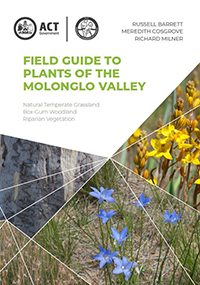 Field Guide to Plants of the Molonglo Valley - Natural Temperate Grassland, Box-Gum Woodland, Riparian Vegetation
Field Guide to Plants of the Molonglo Valley - Natural Temperate Grassland, Box-Gum Woodland, Riparian Vegetation
Botany
Australian Capital Territory Parks and Conservation Service
2018
411
9781921117701
detailed colour photographs for each of the 394 plants in the book
mixed index, including botanical names and common names

Link: You can buy this book from the The National Museum of Australia shop.
The Field Guide to Plants of the Molonglo Valley includes 394 native and exotic species. This covers the majority of all known plant species that occur in the Molonglo Valley and in lowland grassy communities across the region.
The Molonglo Valley is significant for its riverside landscapes, Aboriginal heritage, environmental connectivity, biodiversity and nationally threatened species and ecological communities. Box–gum grassy woodland and natural temperate grassland within the Molonglo Valley provide some of the best representations of these threatened vegetation communities in the region.
The Field Guide to Plants of the Molonglo Valley includes 394 native and exotic forb, grass, sedge, rush, shrub and tree species. For each of these it provides:
- 3 to 9 colour photos per plant
- full-scale size bars of leaf, flower and fruit
- key identification features
- flowering and fruiting times
- habitat type and occurrence
- management information
- known Aboriginal use.
Botanical terms are explained in visual and text glossaries at the front of the book.
This easy-to-use field guide provides a tool to members of the Canberra region to better appreciate, enjoy and understand the diversity of life on their doorstep.
Link: You can buy this book from the The National Museum of Australia shop.

